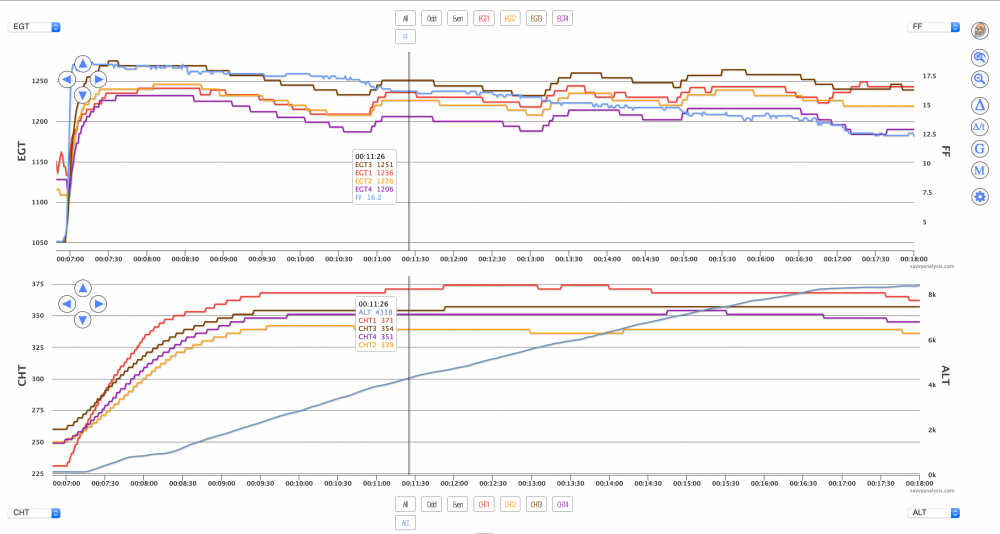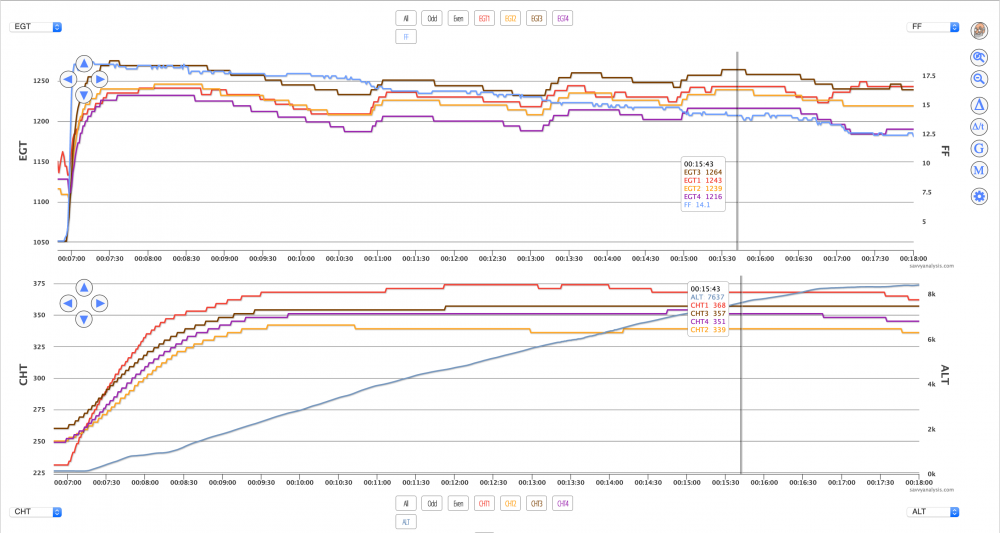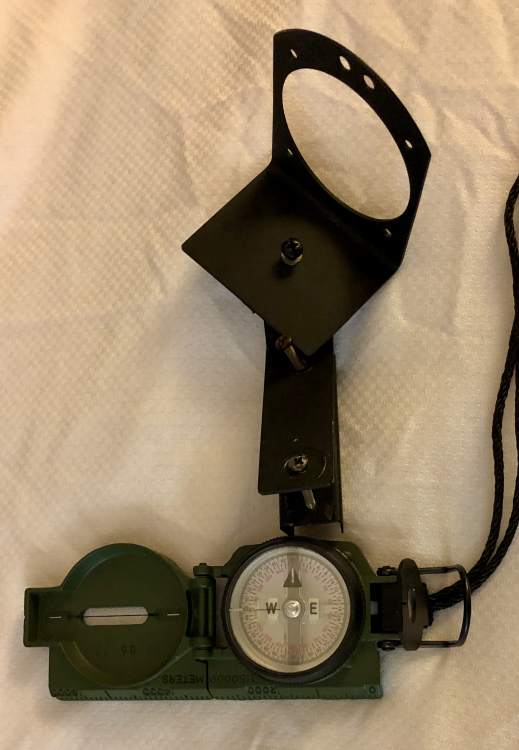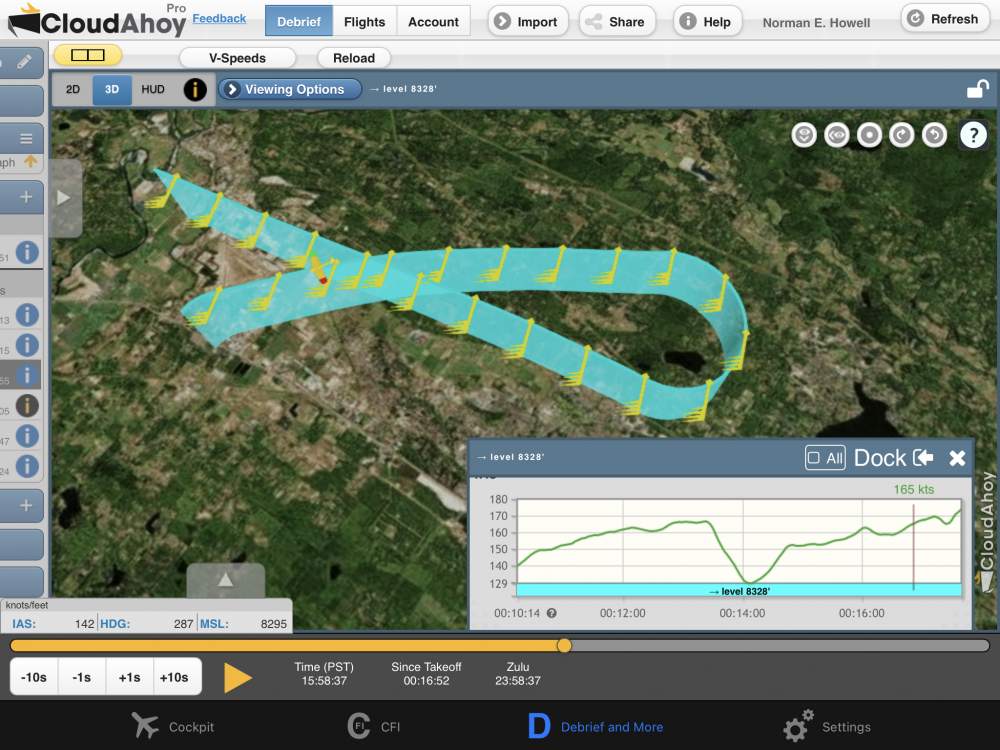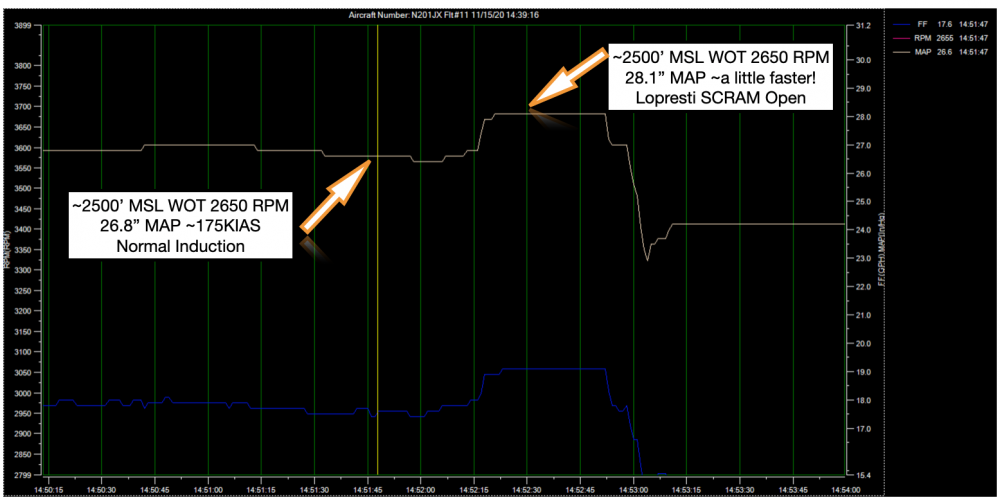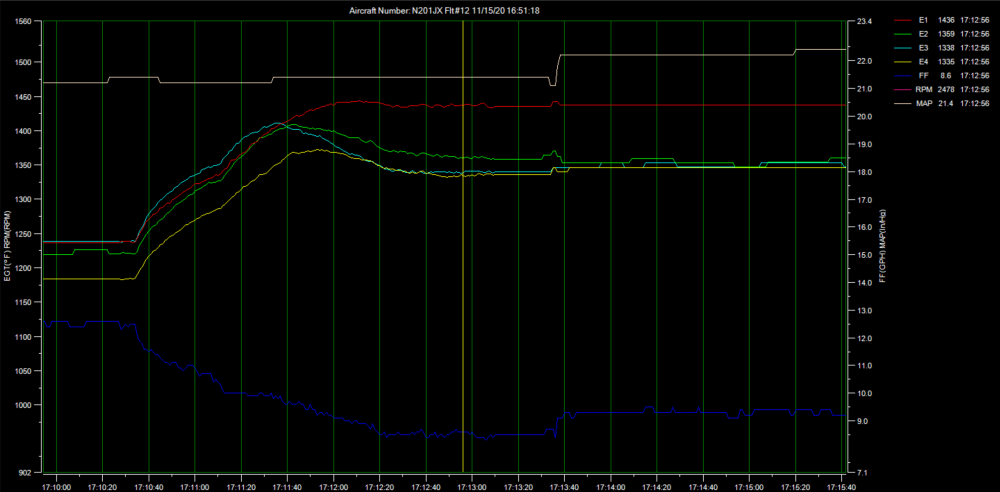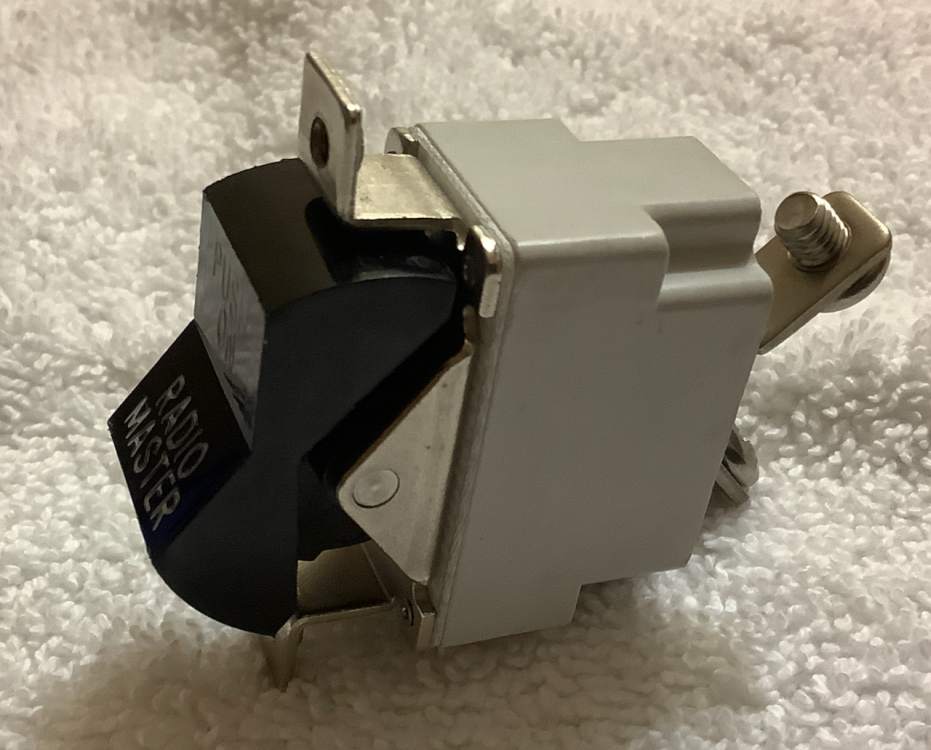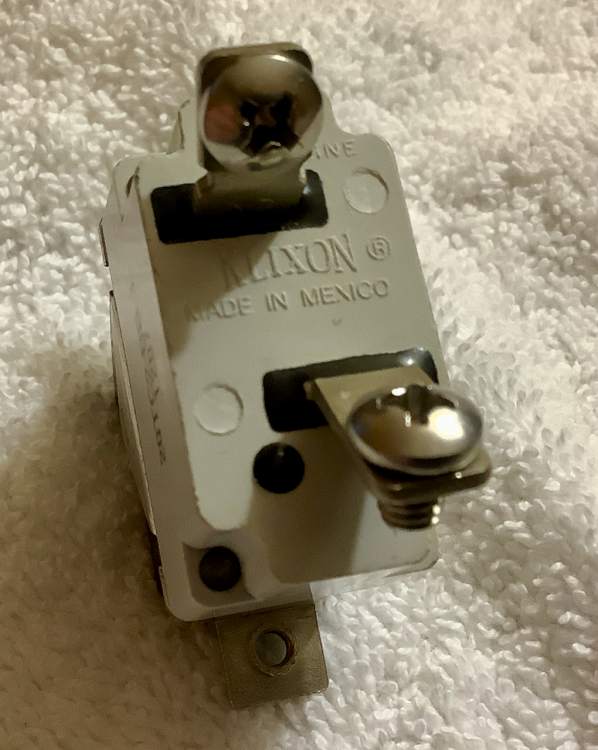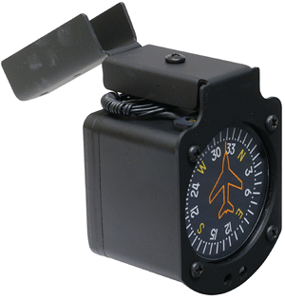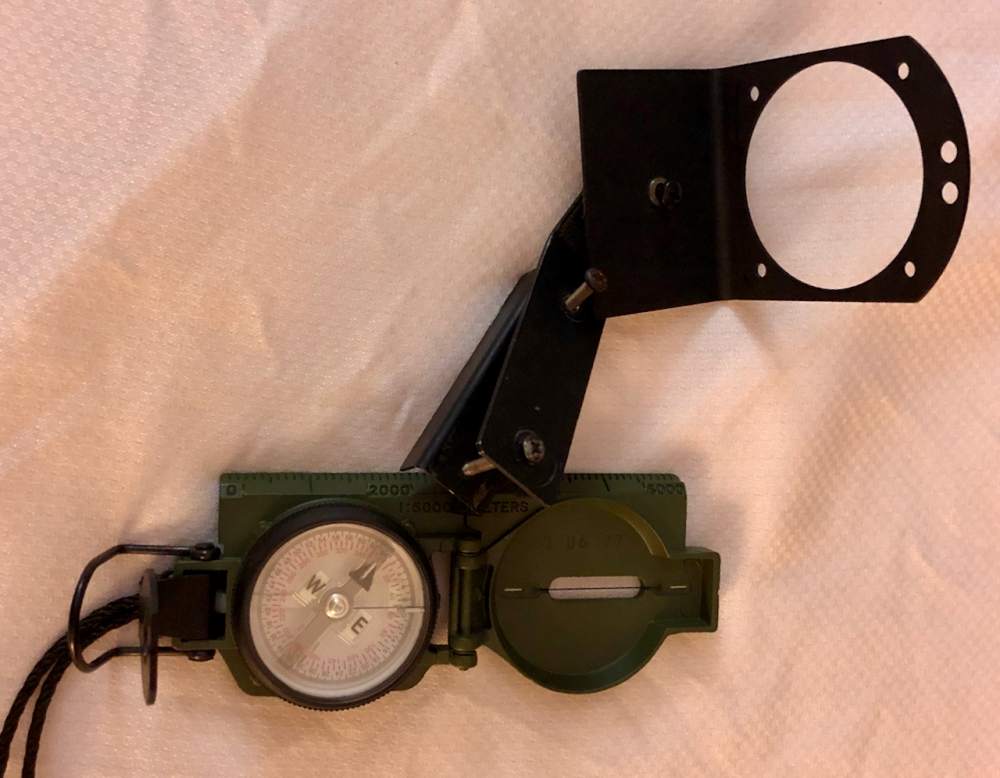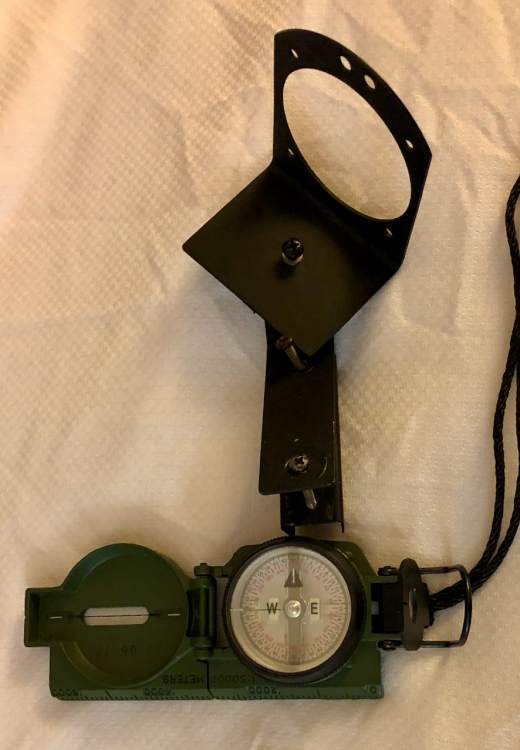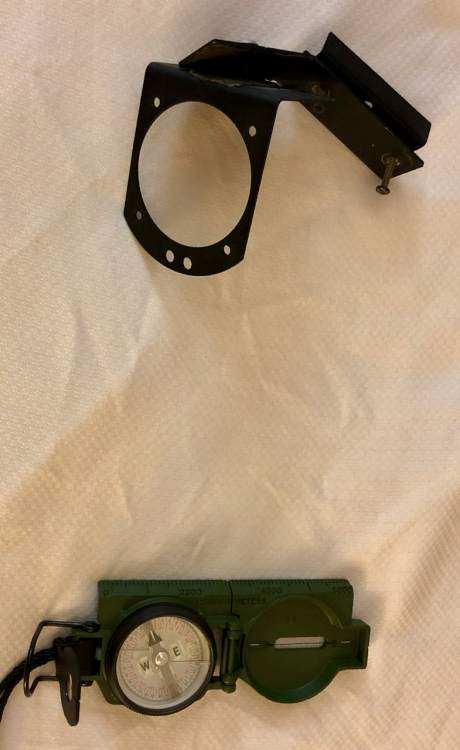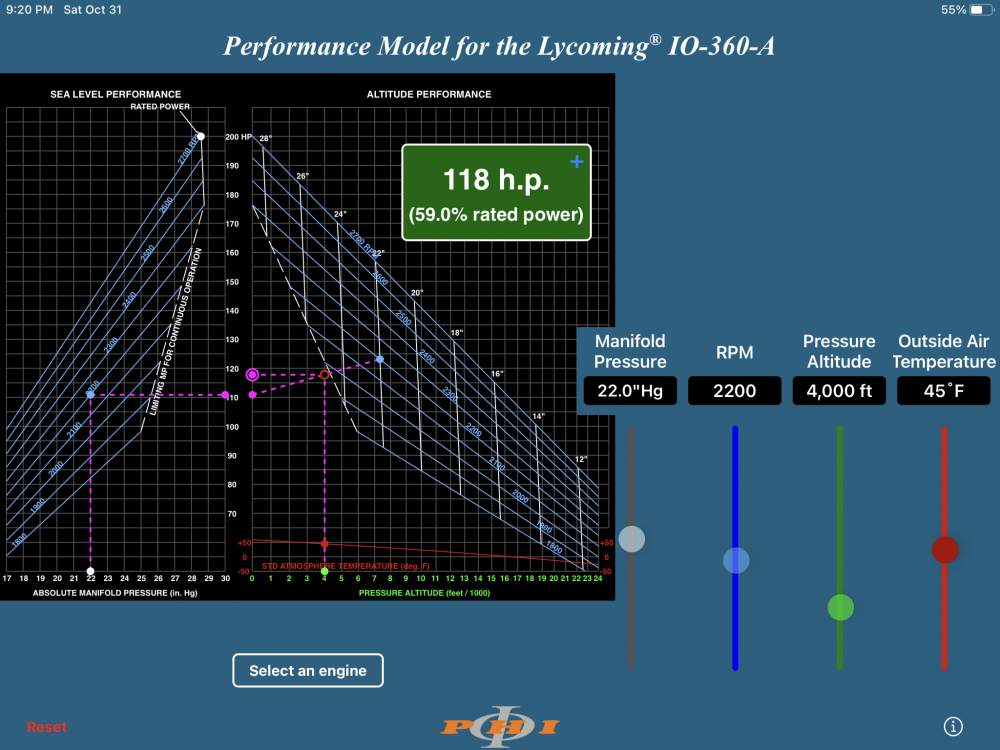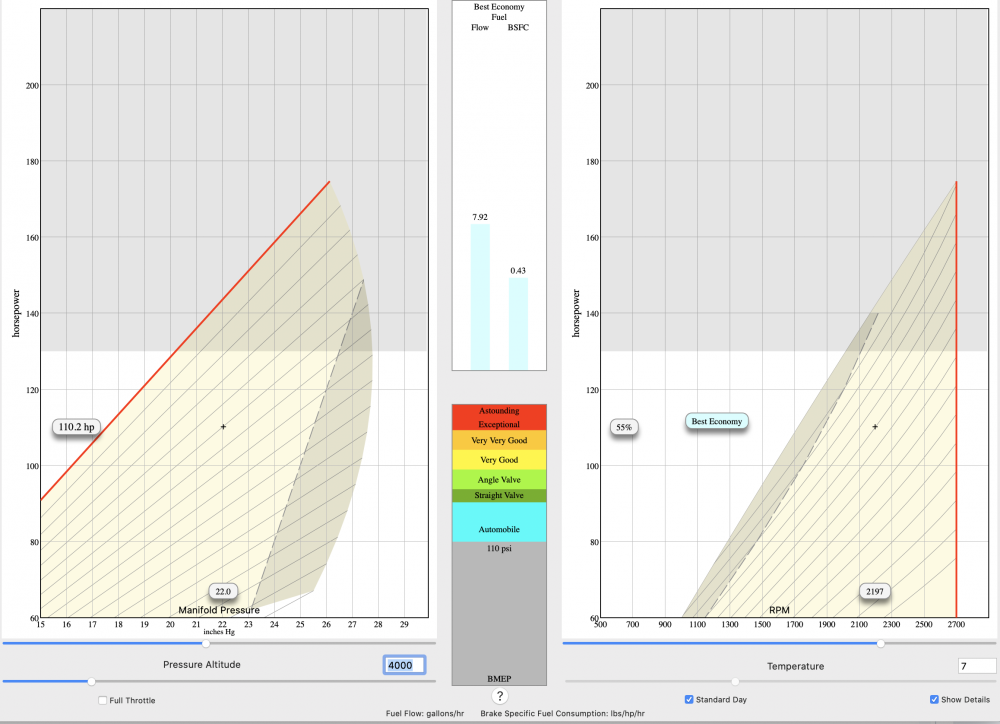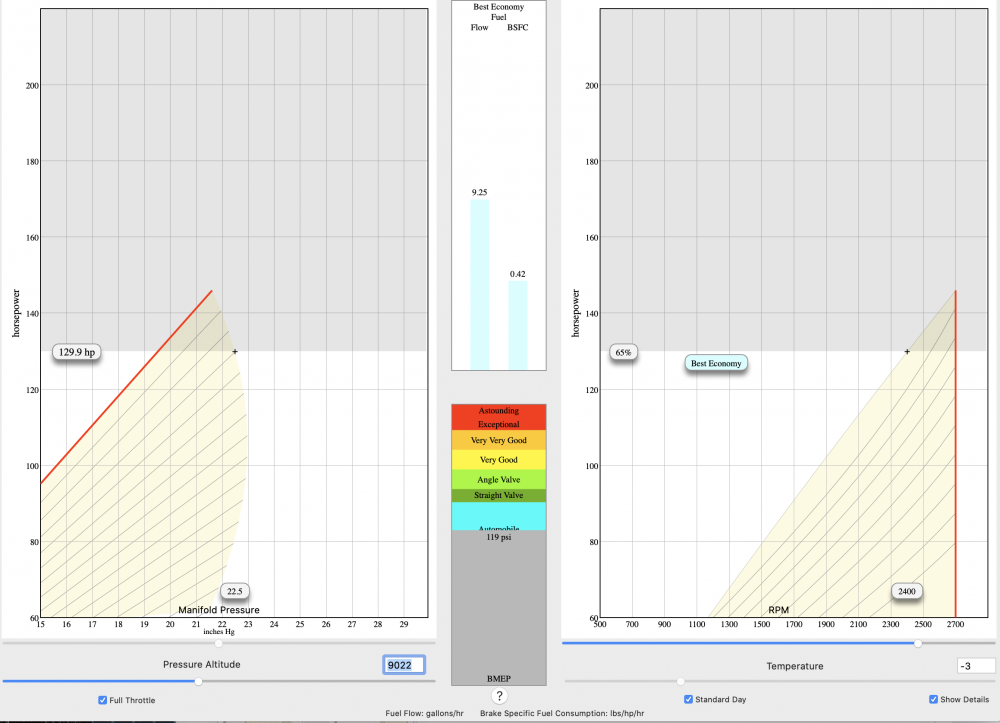-
Posts
588 -
Joined
-
Last visited
-
Days Won
3
Content Type
Profiles
Forums
Blogs
Gallery
Downloads
Media Demo
Events
Everything posted by testwest
-
Hi everyone Here is a play back of an M20J Vz climb profile, starting at the POH initial climb speed with TO flaps of ~72 KIAS. I was a little fast and labeled the segment as 75 KIAS in the video, but the POH number is 72 KIAS. I also said 75 KIAS is the POH speed, it's actually 72. Turn up the sound for narration. [edit: I may re-do the voice over and cut out a couple of flubs with the visual overview display] Then the transition to the Vz profile [113 KCAS (115KIAS) -> 500 fpm -> Vy] is flown and shown in the video. I made another mistake in the voice over, Vz for this airplane is initially 115 KIAS or 113 KCAS. After that is graphs from the Savvy Maintenance analysis tool showing the Target EGT mixture management method during this same climb. Mooney M20J Vz Profile Video.mp4 The graph below shows the data after the first Target EGT mixture pull, from a little over 17 gph (the blue line) to 16 gph or so, EGTs pop back up nicely to near takeoff values, note the altitude and CHTs at the same time in the lower plot. A little later in the Vz climb, this is the third mixture pull, note the EGTs climb back to near the takeoff full rich values, CHTs stay nearly constant and we are at ~7600 feet now. About 115 KIAS or so most of the way up, cowl flaps in trail, CHTs tracking nicely.
- 1 reply
-
- 3
-

-

-
-
We had this issue. The center post is non magnetic stainless steel, but our compass mounting bracket was regular carbon steel and highly magnetized! Replaced it with an aluminum bracket and non magnetic fasteners and the problem was solved.
-
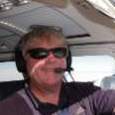
Percent power for a given MP/RPM (Chart discrepancy)
testwest replied to mkrakoff's topic in Modern Mooney Discussion
Bump, how is that upgrade to the 730/830, @mkrakoff? -

Lopresti SCRAM MP increase - quick-look data
testwest replied to testwest's topic in General Mooney Talk
And @y2kiah I like how you present your data! I am going to copy that shamelessly..... -

Lopresti SCRAM MP increase - quick-look data
testwest replied to testwest's topic in General Mooney Talk
Correct, -a-. I see my Cloudahoy data was from the iPad internal GPS even though I was BT'ed to a GDL 52. Hmm. -

Lopresti SCRAM MP increase - quick-look data
testwest replied to testwest's topic in General Mooney Talk
I am pretty sure I got about what you did, this airplane has other drag reductions as well and the gains start to diminish after several have already accumulated. I will need to make some more data runs, it would be better to quote a speed at max gross and standard day conditions, and I was pretty light yesterday and it was cold. BTW I get TAS from a couple of different sources, one from the Aspen display (but it is 2 knots optimistic on the indicated due to the Mooney's position error correction, with down path errors when computing true airspeed) and from the computed TAS from Cloudahoy. Cloudahoy uses ground speed, track angle and known winds at your 4D position to compute TAS. But strong winds aloft can make the data noisy. Having said all that, here is a picture from Cloudahoy: Some take aways, I need to make sure the clock in the EDM-930 is set to GPS time, there is about a 5 minute delta between the engine data and the position data. Note the yellow barbs, about 35 knots of wind aloft and a bit bumpy. On the KTAS graph on the lower right, the speed was actually fairly constant but Cloudahoy's computation of this parameter falls apart in the turn downwind, so you have to let it settle. It is better to quote numbers on a calmer wind day. I was still leaning the last cylinder in the turn and then let it settle for a minute, then opened the SCRAM. The snapshot line on the graph is just a rough number at this point, and heavily caveat-ed. I was level though. The green trace here shows the subsequent descent to the pattern at KAWO. Cloudahoy is a great service. I use it all the time. Highly recommended. -
Hi everyone Finally got N201JX airborne today after way too long, with a new Aspen display, EDM-930 engine display and some other goodies. Took out a bunch of old stuff too and our corrected empty weight (including oil but not unusable fuel ~15lb) is 1750#. I am now FINALLY able to get some much higher fidelity data off this airplane. One of the first things I wanted to check is the max level flight effectiveness of the Lopresti SCRAM (super clean ram air mod) at full power and low altitude. Here is the plot: Bottom line is a 1.3" manifold pressure increase. The hp from Benchmark is 173hp before, and 182hp after. Of course there is a commensurate increase in fuel flow as shown by the blue line. This is an interesting exercise for air racing perhaps, but the real use would be at medium altitude once a full WOT LOP cruise is set up. That will take me a little longer, first indications are a GAMI spread of 1.0 GPH with cylinder 1 being much richer than the others (last to peak). This is at 8500', WOT and 2500 RPM and a little colder than standard day. The normal air filter intake is a little lossy, I only have 21.4" under these conditions. About 8.6 gph LOP but #1 is barely over the peak and #3 is 50 deg lean, and is on a pretty steep negative power slope at this point....meaning ham-fisted leaning might proceed to a rough engine and a nervous pilot. Can't have that. Note here also the SCRAM add on the top yellow MAP line after LOP, from 21.4 to 22.2 inches MAP, increase of .8" and roughly 5 hp. Again a commensurate increase in FF on the blue line, but I did not touch the mixture and the EGTs basically remained constant. Most M20Js are ~155 to 157 KTAS under these conditions. N201JX is nicely faster than this, but I had only one on board and half fuel so pretty light. It's not going 180 KTAS guys, need a turbo or cubic inches for that. More data later. I am thrilled to have this airplane airborne again, finally.
-

Radio Master rocker switch for sale NS - SOLD
testwest replied to testwest's topic in Avionics / Parts Classifieds
Oscar got it! -
Hi everyone I have a new surplus radio master switch/circuit breaker, this is Mooney part number 930023-313A. It is a Klixon style switch with a 3 amp rating: Lake Aero Styling is out of stock on these and their last selling price for this part was an incredible $535.71. See here: https://lasar.com/switches/rocker-switch-radio-master-circuit-breaker-930023-313a I would like to get $150 OBO plus shipping (USPS Priority Mail works pretty good). Send PM if interested. Note this is a regular 3 amp Klixon 20TC2-BB-3, where the BB is the rocker color and the 3 is the amp rating. Very important, if you decide to use this switch body in some other function that requires three amps, you will need to install the switch cover flipped 180 deg for normal function. Mooney does a non-intuitive thing here, to turn the radio master circuit on, the switch is moved up to off (single pole open)! This is to remove hold-open power for the radio master relay. BTW for trivia, the starter solenoid, when engaged, will also route power to the radio master relay to hold it open (radios go off for engine start). Super trivia, pulling the aux bus circuit breaker will also remove the hold open power on the radio master relay. Pull that circuit breaker with the master switch on and watch the radios come on. A great way to win beers from your airport buddies.
-
Rags is correct, I have accessed the configuration pages on the Garmin 430 myself to correct a very similar problem. And it worked.
-

How best to deal with malfunctioning vertical card compass
testwest replied to DXB's topic in General Mooney Talk
Our M20J has had the same issue, the magnetic compass and the subsequent vertical card compass that replaced it both were always difficult to swing. Our VCC was previously mounted on the original mag compass bracket, but it was installed before PAI had the Mooney-specific bracket available: This is available here: https://www.aircraftspruce.com/catalog/inpages/pacmovmn.php While removing the old mount to put on this new one, I noticed the screws and nuts holding the old bracket on were plain cadmium-plated steel (#6 machine screws). In examining the removable u-channel the screws went through, I noticed it had been repainted with a brush and there was some small areas of rust visible. Ruh-roh. The center windshield post is a stainless steel tube 3/4" in diameter and is non magnetic. But the U-channel I removed was regular steel. I decided to check the bracket components against a new military grade lensatic survival compass. And the results were astonishing, to say the least: IMG_0576.mp4 IMG_0581.mp4 As you can see, the OEM bracket has been strongly magnetized. It's off the airplane now and I am going to do a new swing on this PAI VCC this weekend, on the brand new compass rose at Arlington airport (KAWO). And I will report on the results. -

Percent power for a given MP/RPM (Chart discrepancy)
testwest replied to mkrakoff's topic in Modern Mooney Discussion
Excellent, you will like that 730/830 upgrade. Be sure to look at the setup menus and record data at the highest possible rate, I think it is once every two seconds is the highest rate choice. -

Percent power for a given MP/RPM (Chart discrepancy)
testwest replied to mkrakoff's topic in Modern Mooney Discussion
Oh yes, the M20J airplane model, "as installed" engine model and several M20J props are on the Seqair site, so you can download those two and start right in. -

Percent power for a given MP/RPM (Chart discrepancy)
testwest replied to mkrakoff's topic in Modern Mooney Discussion
Anytime! Looking forward to the data. What kind of engine analyzer do you have? -

Percent power for a given MP/RPM (Chart discrepancy)
testwest replied to mkrakoff's topic in Modern Mooney Discussion
Bump, hoping for @mkrakoff to reply back here! -

Percent power for a given MP/RPM (Chart discrepancy)
testwest replied to mkrakoff's topic in Modern Mooney Discussion
@skykrawler, you are correct. The Aircraft Power app uses the Lycoming charts for its calculations. And the IO-360-A**** are all on the same chart. Here is a screen shot from the app for @mkrakoff 's conditions of standard day, 22"/2200 and 4000 feet pressure altitude: As stated before, this is not the "as-installed" power in a stock Mooney M20J. This power setting and atmospheric conditions is 55% power in a J. More below! Mooney was very accurate in its engine power data gathering for the M20J effort. In particular, the airborne engine torque meter, fuel flow instrumentation and air data instrumentation were the best obtainable for a GA airplane in 1975-76, and the flight test engineers, Roy Lopresti, and Fen and Dorothy Taylor, were without peer. I modeled the M20J IO-360-A3B6D "as-installed" power in Benchmark. Here is a chart under the same conditions as before: This chart shows 55% in the J, right on the money. And of course, Benchmark allows any combination of every possible MP/RPM/Temp/ALT, just like the OP, @mkrakoff wanted! So, let's find the lowest altitude where WOT and, say, 2400 RPM gives exactly 65% power, and what the book fuel flow would be at best economy (which in this case is 25 degrees rich of peak EGT, that's how Mooney did it): So, for @mkrakoff , fly your airplane to 9000 feet density altitude (note for here it is a standard day, so 29.92" altimeter and -3 deg C in the chart is 9000 ft pressure altitude as well as density altitude). Go wide open throttle and 2400 RPM (hopefully your tachometer has been recently calibrated). Slowly lean back to 9.3 to 9.2 gallons per hour. Ideally, you should see 22.5" MP under these conditions, and none of the cylinders has passed peak EGT yet. Manage your cowl flaps to keep the hottest cylinder below 380 deg F. At cruise you "should" not have to worry and you should be able to run cowl flaps closed. Let the engine stabilize, then slowly lean some more. Your first EGT should peak about 25 degrees higher and the fuel flow should be about 8.7 gph. If your first cylinder peaked at 8.8 gph and the last at 8.6 gph you have a really good baseline and your airplane is pretty close to the type design, and you are pretty much exact at 65%! And you could probably run LOP very nicely without GAMIs. Many Lycomings can do this. On the other hand, under these same conditions, if you get a first peak at "something like" 9 gph and a last at 8.2, you have a high GAMI spread and GAMIs would help. If it's really bad you engine might feel a little rough before the last cylinder peaks. Or, at WOT if you are getting significantly less than 22.5 inches MAP you may have a restriction in the induction system somewhere. A 1" loss under these conditions (21.5" at WOT) equals a 3% power loss, so your peaks would be around 8.3 gph instead of 8.7. I got this answer instantly "flying" the Benchmark power chart just like flying the airplane. Now then. I would like you to please go fly these numbers and report back your data. And we will go from here. Hint, we will look at cruise performance next. You should see about 138-139 KCAS, or about 2 knots higher indicated (which computes to ~158 KTAS) in the stated conditions above and around 2600 lb GW. Draggy stuff on the airplane will knock that down some, so the common wisdom is that the J is a 155 knot true airspeed flyer under every day 65% power conditions. -

Looking for trim tab replacement plastic
testwest replied to TravelVeteran's topic in General Mooney Talk
What Andy95W said. Plane Plastics has molds for many other parts besides the approved ones in their catalogs. They are manufactured as an "owner-produced part" instead of under a PMA. Remember the owner produced part rules are for parts you, the owner, manufacture or cause to be manufactured. To do this, you have to send your old part in to get a replacement, but they do send the old part back. FAA rules on this I suppose. I got three speaker covers as well, they were an "unapproved" part (meaning no PMA). Only sent one in and got it back, plus two to install and one spare. -
You are welcome, and good luck!
-

Vz Presentation is Available in Downloads
testwest replied to testwest's topic in General Mooney Talk
Bump, 20 downloads so far! -

Vz Presentation is Available in Downloads
testwest replied to testwest's topic in General Mooney Talk
Thanks, Toto, for the feedback!! We should go flying sometime. I would count watching the presentation as the one hour of ground instruction for a flight review! -

Vz Presentation is Available in Downloads
testwest replied to testwest's topic in General Mooney Talk
If someone wants to blast their monthly bandwidth budget, the full resolution version of the presentation, at 3.5GB, can be downloaded at https://www.dropbox.com/s/nn8vn07b605wlo0/Capto_Capture%202020-10-13_11-00-11_PM.mp4?dl=0 Let me know how it works! -

Vz Presentation is Available in Downloads
testwest replied to testwest's topic in General Mooney Talk
OK, everyone, thanks for the feedback. I am uploading two better versions of this presentation. One is a 1080p resolution (called Introducing Vz - Medium Rez), it is 2.4GB though, so caution if you are bandwidth limited. And the other one (Introducing Vz - Medium Low Rez) is 1.26GB at 720. These should be a lot better than the small web version, which was really too pixelated to be useful. Just waiting on the moddies to approve. Sorry for being too gun shy on the bandwidth, I remember when a 9600 baud modem was a hot ticket. -

Vz Presentation is Available in Downloads
testwest replied to testwest's topic in General Mooney Talk
OK, thanks for the feedback! I’ll crunch out a higher resolution version and upload. -

Vz Presentation is Available in Downloads
testwest replied to testwest's topic in General Mooney Talk
I may upload a higher resolution version of this, but it might be 800mb or more, wondering what the tolerance for download file size is.....


